Identification of Dielectric Response Parameters of Pumped Storage Generator-Motor Stator Winding Insulation Based on Sparsity-Enhanced Dynamic Decomposition of Depolarization Current
Abstract
1. Introduction
- (1)
- Establishing an EDM that accurately represents the epoxy–mica composite insulation system of stator windings. At present, the process of constructing EDMs for the insulation of capacitive electrical equipment is largely based on expert experience, where the number of branches in the model is estimated using prior knowledge. This approach places high demands on the experience level of on-site testing personnel. To address this issue, the authors of ref. [12] propose construct-ing EDM by enumerating multiple branch numbers and fitting the current based on each model, then selecting the model with the highest fitting accuracy. Although this method partially addresses the issue of determining the number of branches, artificially setting the number of branches solely to achieve better fitting accuracy undermines the physical significance of each branch in the EDM. The authors of ref. [13] determined the number of branches in the model by differentiating the depolarization current and identifying the number of local maxima in the resulting differential curve. Although this method can automatically determine the number of branches in the model, it has drawbacks such as high computational complexity, a relatively intricate calculation process, and strong sensitivity to noise, making it unsuitable for rapid diagnostics in engineering field applications.
- (2)
- Precisely identifying the model parameters based on PDC test data. Currently, traditional approaches rely on fitting methods, where the expression of the polarization/depolarization current is derived from a predefined model, and fitting algorithms are then used to solve for the branch parameters. In recent years, intelligent optimization algorithms such as genetic algorithms (GAs) [14], the gray wolf optimizer (GWO) [15], and the Cuckoo search (CS) algorithm [16] have been increasingly adopted to improve fitting accuracy. However, although these methods can quickly find results with very high fitting accuracy, they still require manual setting of the branch number. As mentioned earlier, these approaches not only lose the physical significance of the EDM but also struggle to detect changes in the number of branches.
2. Principle of Diagnosing Stator Winding Insulation Condition Based on the PDC Method
3. EDM Parameter Identification Method Based on Sparsity-Enhanced Dynamic Decomposition of Depolarization Current
3.1. Dynamic Decomposition of the Depolarization Current Sequence
3.2. Sparsity Enhancement Method Based on the IRL1-ADMM Method
- (1)
- Introducing the auxiliary variable z, reformulate Equation (19) as follows:The corresponding augmented Lagrangian function is:where μ denotes the Lagrange multiplier and ρ > 0 is the penalty parameter of the augmented term.
- (2)
- Iteratively update α, z, and μ:
- (3)
- Update the weights and repeat until the convergence criterion is satisfied. After the inner-layer ADMM converges, the weights are updated as follows:Repeat the outer IRL1 iterations until the following convergence criterion is satisfied:where δ is the convergence threshold. After extensive computational analysis and considering both computational complexity and efficiency, δ is set to 0.001 in this study.The optimal solution αsp can be obtained through the above solution process, as expressed in Equation (24):where I is the identity matrix, and E consists of unit column vectors for which the nonzero elements correspond to the zero components of α.
4. Method Validation
4.1. Simulation Validation
4.2. Experimental Validation
4.2.1. Experimental Sample Setup
4.2.2. Insulation Condition Assessment
4.2.3. Material Performance Testing of Samples for Validation
5. Conclusions
- (1)
- To address the limitation of traditional methods in accurately determining the number of branches in the EDM, this study employs the DMD algorithm to decompose the depolarization current into distinct modes. The dominant modes are automatically extracted and used to determine the number of branches, thereby enabling precise identification of both the number and parameters of EDM branches. This approach effectively overcomes the reliance on extensive expert experience or the blind pursuit of fitting accuracy commonly seen in traditional methods.
- (2)
- Building on the dynamic decomposition of the depolarization current, this study proposes the use of the IRL1 method to construct a reconstruction error minimization problem, which is solved via the ADMM algorithm. This approach enables the precise selection of dominant modes and accurately determines the number of EDM branches even under low SNR conditions. As a result, the robustness of the proposed method against noise in field testing environments is significantly enhanced, enabling joint and accurate identification of both the model’s branch number and parameters. It effectively addresses the limitation of traditional methods, which fail to reliably identify the number of EDM branches under low SNR scenarios.
Author Contributions
Funding
Data Availability Statement
Conflicts of Interest
Abbreviations
| PDC | Polarization and Depolarization Current |
| EDM | Extended Debye Model |
| DMD | Dynamic Mode Decomposition |
| IRL1 | Iterative Reweighted L1 |
| ADMM | Alternating Direction Multiplier Method |
| SVD | Singular Value Decomposition |
| LASSO | Least Absolute Shrinkage and Selection Operator |
| SNR | Signal-to-noise Ratio |
| VPI | Vacuum Pressure Impregnation |
| SEM | Scanning Electron Microscope |
| FTIR | Fourier-Transform Infrared Spectroscopy |
References
- Potrč, S.; Čuček, L.; Martin, M.; Kravanja, Z. Sustainable renewable energy supply networks optimization—The gradual transition to a renewable energy system within the European Union by 2050. Renew. Sustain. Energy Rev. 2021, 146, 111186. [Google Scholar] [CrossRef]
- Yang, W.; Yang, J. Advantage of variable-speed pumped storage plants for mitigating wind power variations: Integrated modelling and performance assessment. Appl. Energy 2019, 237, 720–732. [Google Scholar] [CrossRef]
- Bartnikas, R.; Morin, R. Multi-stress aging of stator bars with electrical, thermal, and mechanical stresses as simultaneous acceleration factors. IEEE Trans. Energy Convers. 2004, 19, 702–714. [Google Scholar] [CrossRef]
- Xie, Y.; Zhang, J.; Leonardi, F.; Munoz, A.R.; Degner, M.W. Investigation of Surge Voltage Propagation in Inverter-Driven Electric Machine Windings. IEEE Trans. Ind. Electron. 2023, 70, 9811–9822. [Google Scholar] [CrossRef]
- Stone, G.C.; Culbert, I.; Boulter, E.A.; Dhirani, H. Electrical Insulation for Rotating Machines: Design, Evaluation, Aging, Testing, and Repair; John Wiley & Sons: Hoboken, NJ, USA, 2014. [Google Scholar]
- Zhang, M.; Shao, D.; Liu, J.; Peng, S.; Tang, M.; Jia, H.; Yu, M. Study on the change of the oil-paper insulation’s AC conductivity characteristics based on dielectric response in frequency domain. Measurement 2025, 243, 116346. [Google Scholar] [CrossRef]
- Xu, L.; Zhang, D.; Jiang, J.; Mu, H.; Zhang, G. Dielectric response characteristics and moisture exposure evaluation of oil-paper insulation based on microstrip ring resonator. Measurement 2024, 234, 114770. [Google Scholar] [CrossRef]
- Li, Y.; Peng, Z.; Xu, D.; Huang, S.; Gao, Y.; Li, Y. Research on the Thermal Aging Characteristics of Crosslinked Polyethylene Cables Based on Polarization and Depolarization Current Measurement. Energies 2024, 17, 2274. [Google Scholar] [CrossRef]
- Mustafa, E.; Afia, R.S.A.; Nawaz, A.; Nouini, O.; Tamus, Z.Á. Implementation of Non-Destructive Condition Monitoring Techniques on Low-Voltage Nuclear Cables: II. Thermal Aging of EPR/CSPE Cables. Energies 2022, 15, 3231. [Google Scholar] [CrossRef]
- David, E.; Soltani, R.; Lamarre, L. PDC measurements to assess machine insulation. IEEE Trans. Dielectr. Electr. Insul. 2010, 17, 1461–1469. [Google Scholar] [CrossRef]
- Jiang, Z.; Liu, J.; Fan, X.; Zhang, H.; Gong, H.; Zhou, J. Dielectric feature parameters database using for aging state evaluation of traction transformer insulation at hotspot region. IEEE Trans. Transp. Electrif. 2024, 10, 2619–2628. [Google Scholar] [CrossRef]
- Morsalin, S.; Phung, B.T. Dielectric response study of service-aged XLPE cable based on polarisation and depolarisation current method. IEEE Trans. Dielectr. Electr. Insul. 2020, 27, 58–66. [Google Scholar] [CrossRef]
- Chen, Q.; Wang, W.; Cai, D. Micro-Decomposition Spectrum and Parameter Identification Based on Depolarization Current Curve. In Proceedings of the 2023 International Conference on Applied Physics and Computing (ICAPC), Ottawa, ON, Canada, 27–29 December 2023. [Google Scholar] [CrossRef]
- Yang, F.; Du, L.; Yang, L.; Wei, C.; Wang, Y.; Ran, L.; He, P. A Parameterization Approach for the Dielectric Response Model of Oil Paper Insulation Using FDS Measurements. Energies 2018, 11, 622. [Google Scholar] [CrossRef]
- Liao, W.; Zhou, L.; Li, Z.; Wang, D.; Zhang, J.; Cai, J. An IGBA Algorithm-Based Curve Reconstruction Method of Frequency-Domain Dielectric Spectroscopy for OIP Bushing With Nonuniform Moisture Distribution. IEEE Trans. Transp. Electrif. 2021, 7, 3194–3203. [Google Scholar] [CrossRef]
- Wang, D.; Zhou, L.; Yang, Z.; Cui, Y.; Wang, L.; Jiang, J. A New Testing Method for the Dielectric Response of Oil-Immersed Transformer. IEEE Trans. Ind. Electron. 2020, 67, 10833–10843. [Google Scholar] [CrossRef]
- Ye, G.; Li, H.; Lin, F.; Tong, J.; Wu, X.; Huang, Z. Condition assessment of XLPE insulated cables based on polarization/depolarization current method. IEEE Trans. Dielectr. Electr. Insul. 2016, 23, 721–729. [Google Scholar] [CrossRef]
- Kumar, A.; Mishra, D.; Baral, A. Importance of Depolarization Current in the Diagnosis of Oil-Paper Insulation of Power Transformer. IEEE Access 2023, 11, 56858–56864. [Google Scholar] [CrossRef]
- Schmid, P.J. Dynamic mode decomposition of numerical and experimental data. J. Fluid Mech. 2010, 656, 5–28. [Google Scholar] [CrossRef]
- Schmid, P.J. Dynamic mode decomposition and its variants. Annu. Rev. Fluid Mech. 2022, 54, 225–254. [Google Scholar] [CrossRef]
- Zhu, G.; Liu, Z.; Pan, S.; Meng, P.; Zhou, K.; Wang, X. A dampness discrimination method for MV power cable joints based on PDC testing under thermal excitation conditions. IEEE Trans. Dielectr. Electr. Insul. 2024, 31, 581–588. [Google Scholar] [CrossRef]
- Zhang, Y.; Jiang, F.; Yu, X.; Zhou, K.; Zhang, W.; Fu, Q. Assessment of thermal aging degree of 10 kV cross-linked polyethylene cable based on depolarization current. IEEE Access 2021, 9, 111020–111029. [Google Scholar] [CrossRef]
- Varganici, C.D.; Rosu, L.; Rosu, D.; Rosca, I.; Ignat, M.E.; Ignat, L. Surface Degradation of DGEBA Epoxy Resins Cured with Structurally Different Amine Hardeners: Effects of UV Radiation. Polymers 2023, 16, 67. [Google Scholar] [CrossRef] [PubMed]
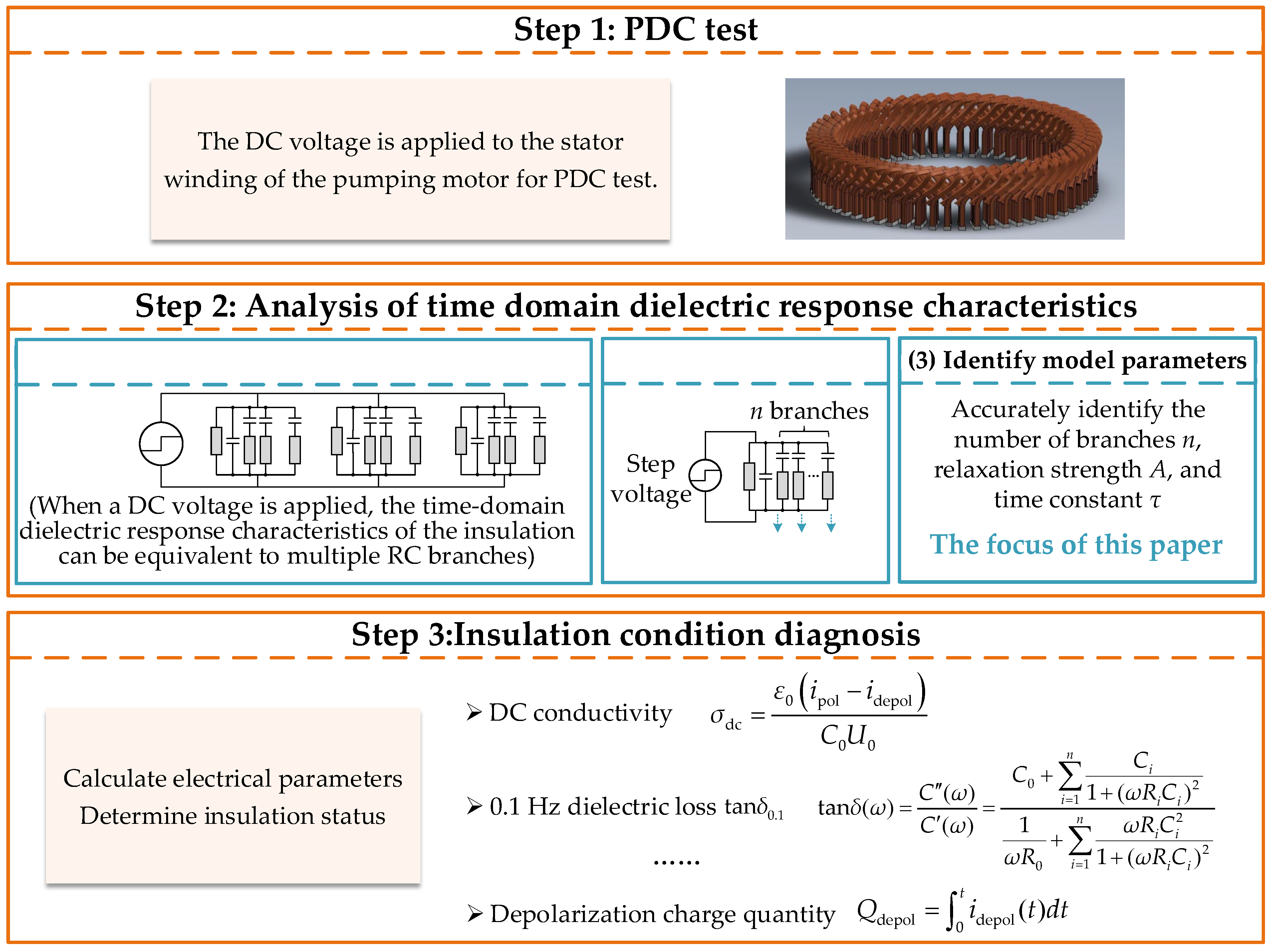
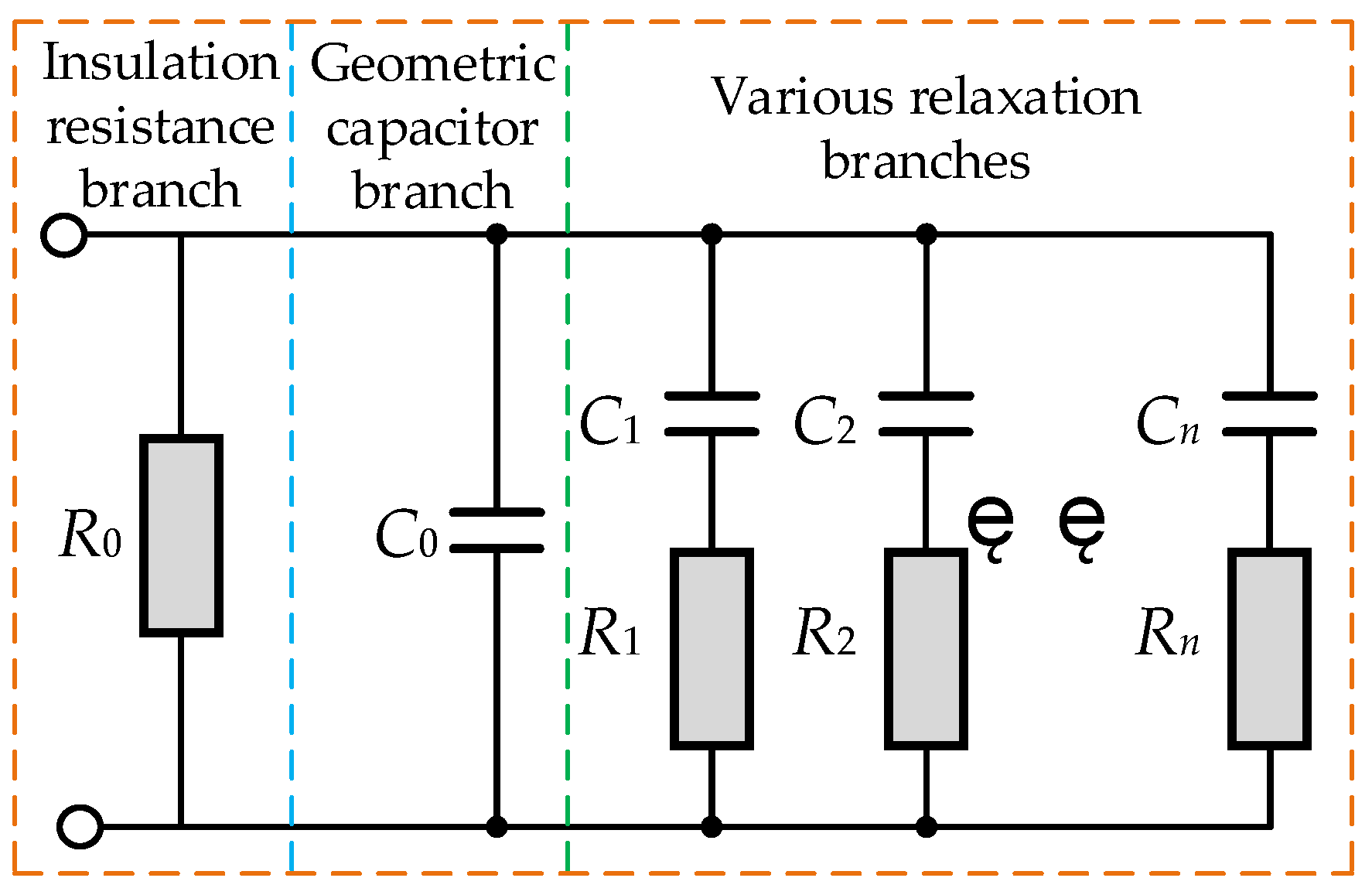
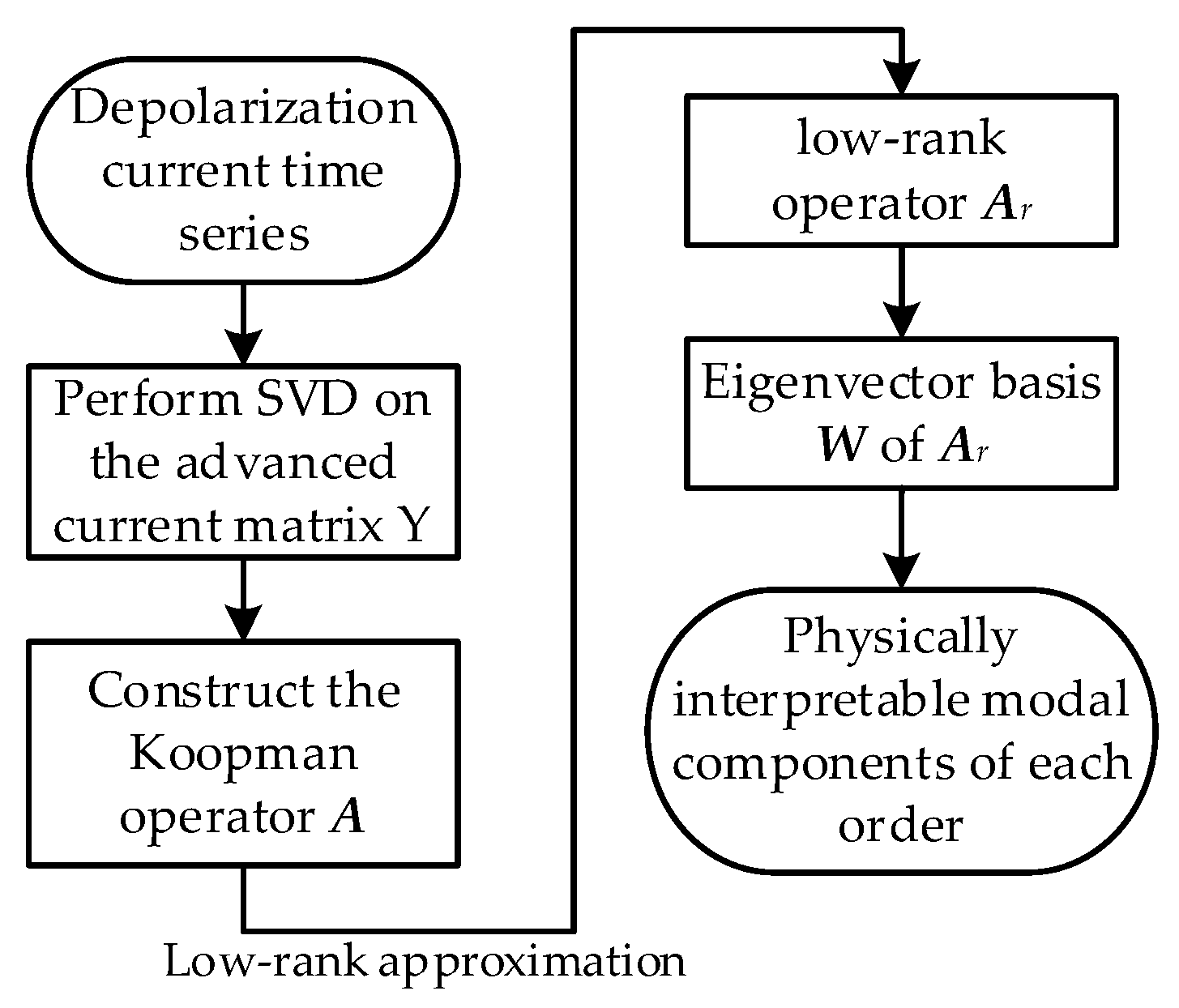
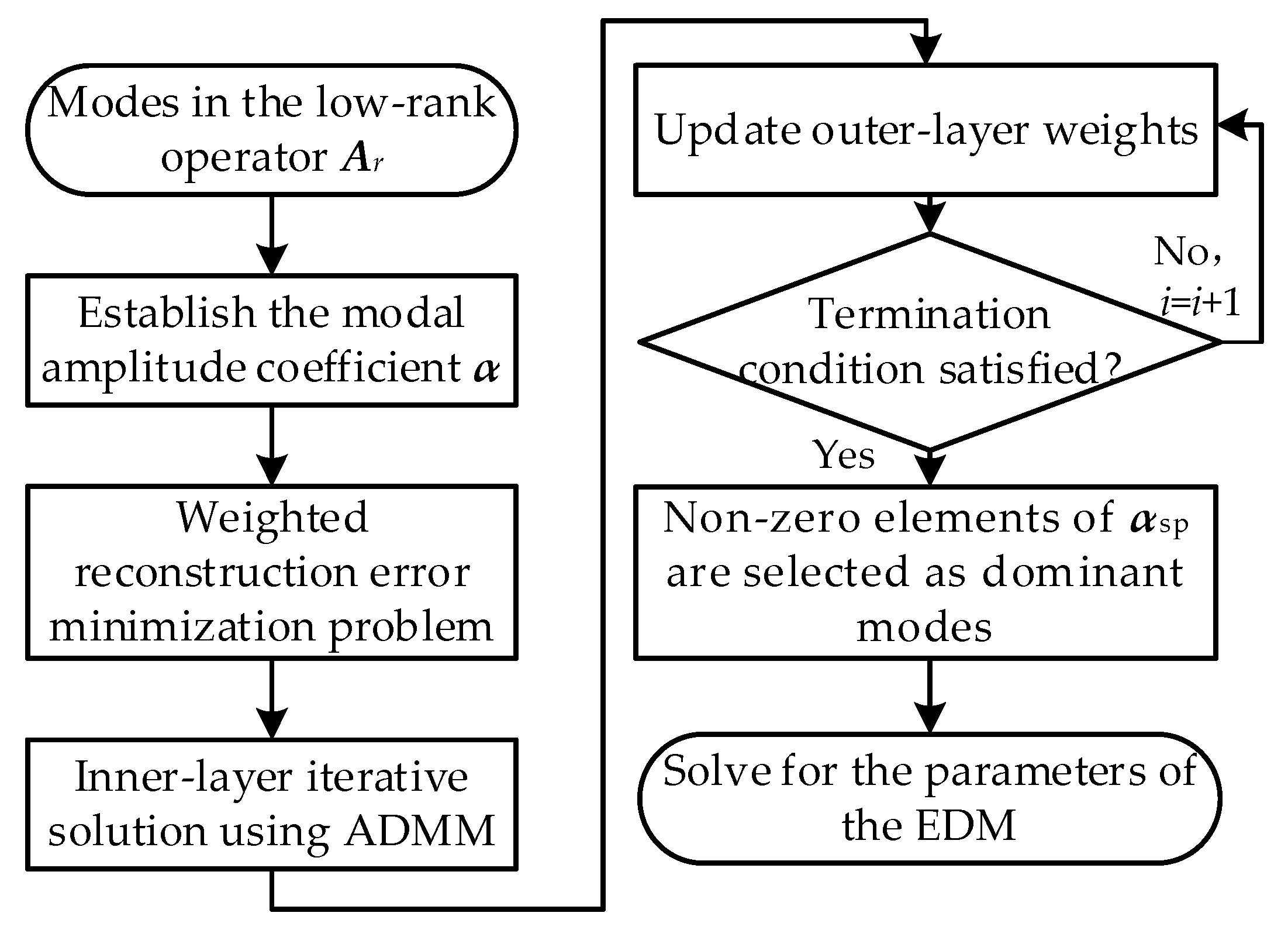

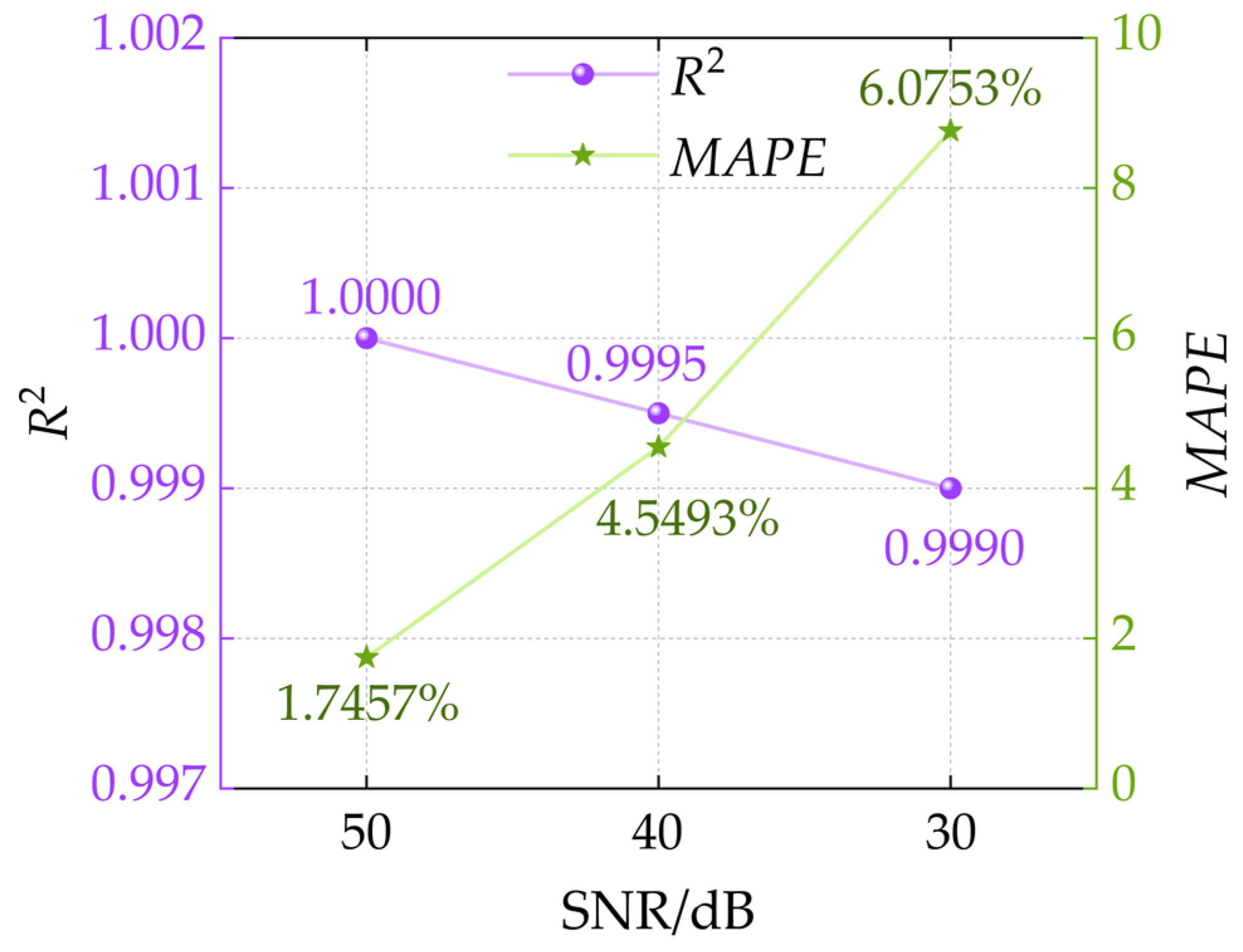
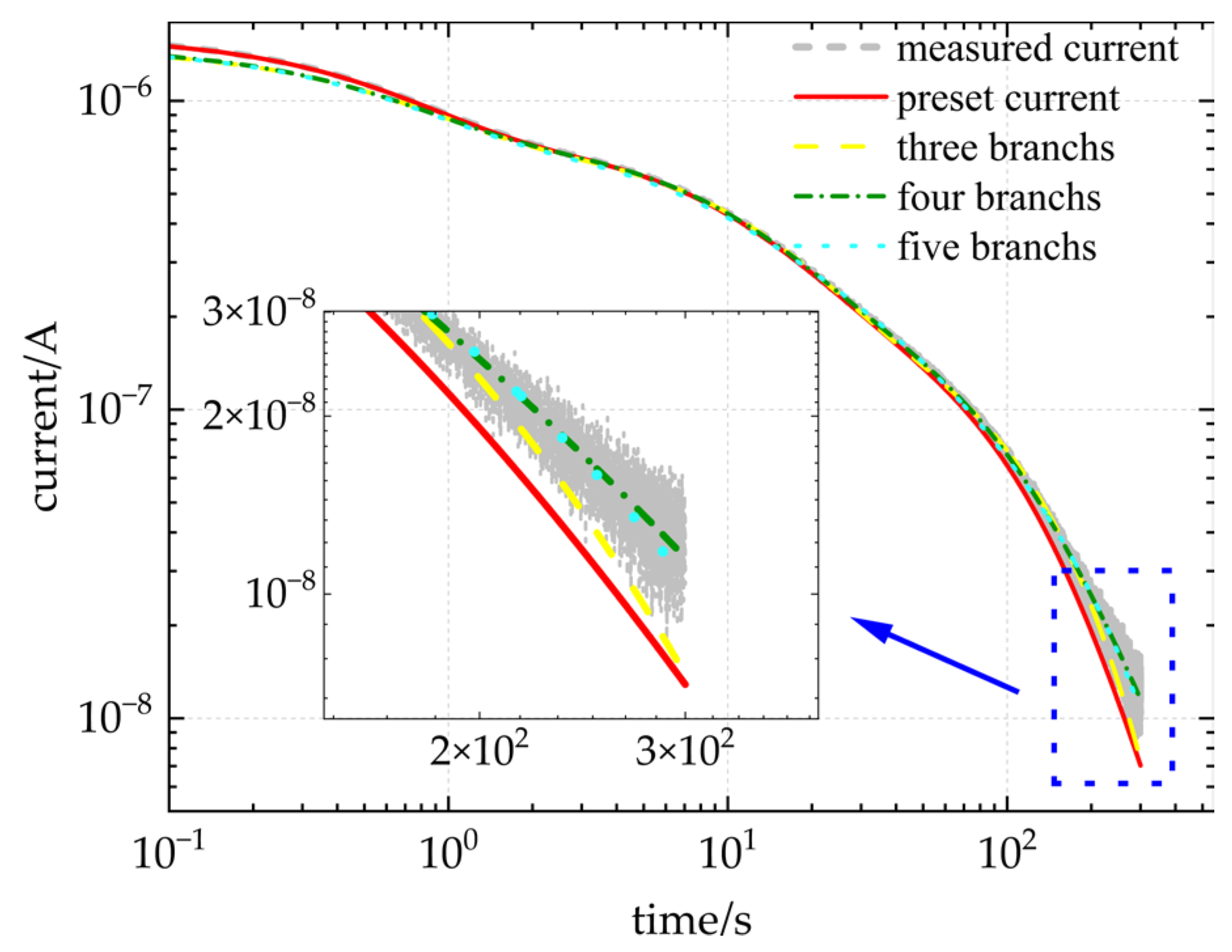

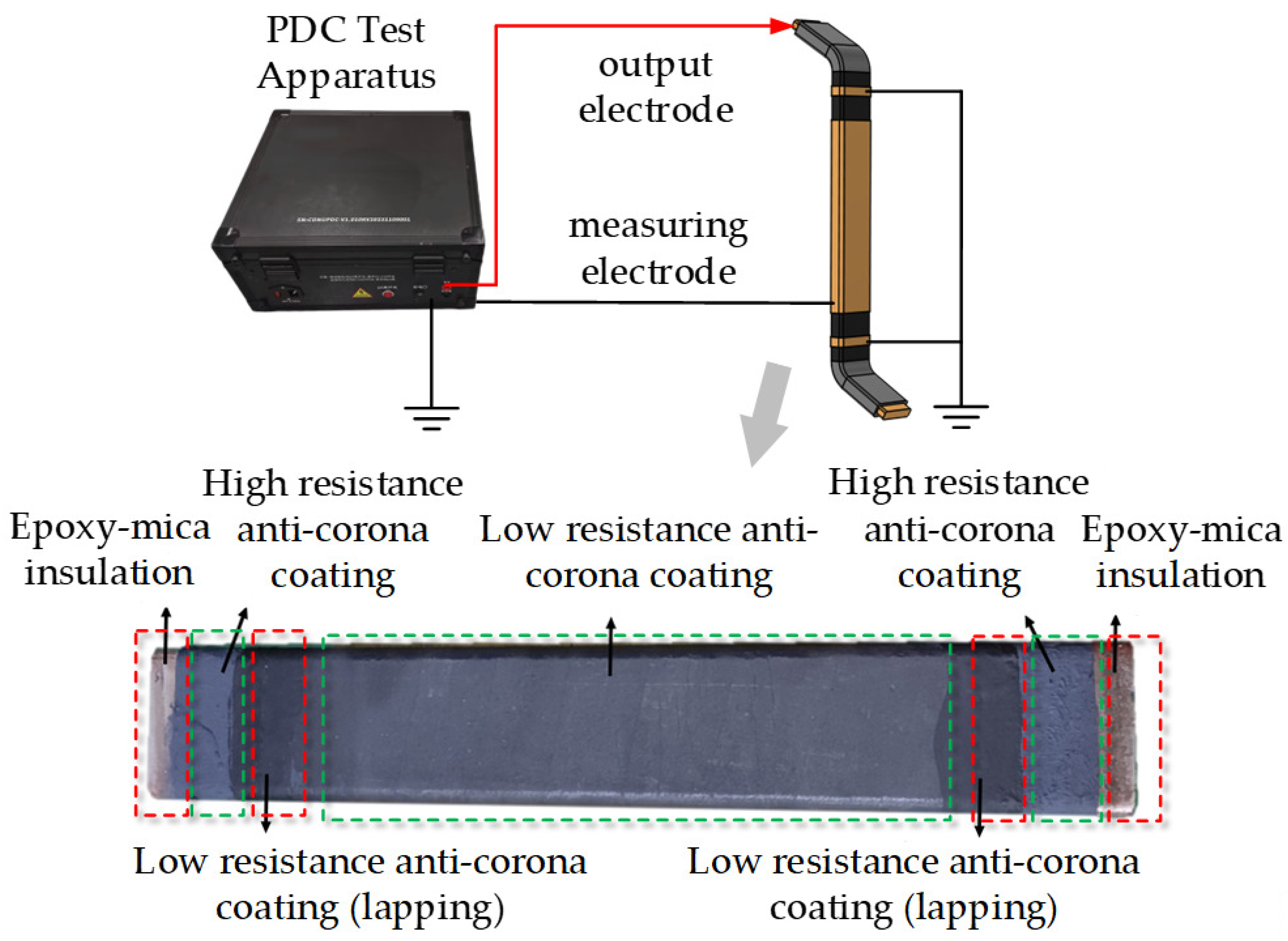

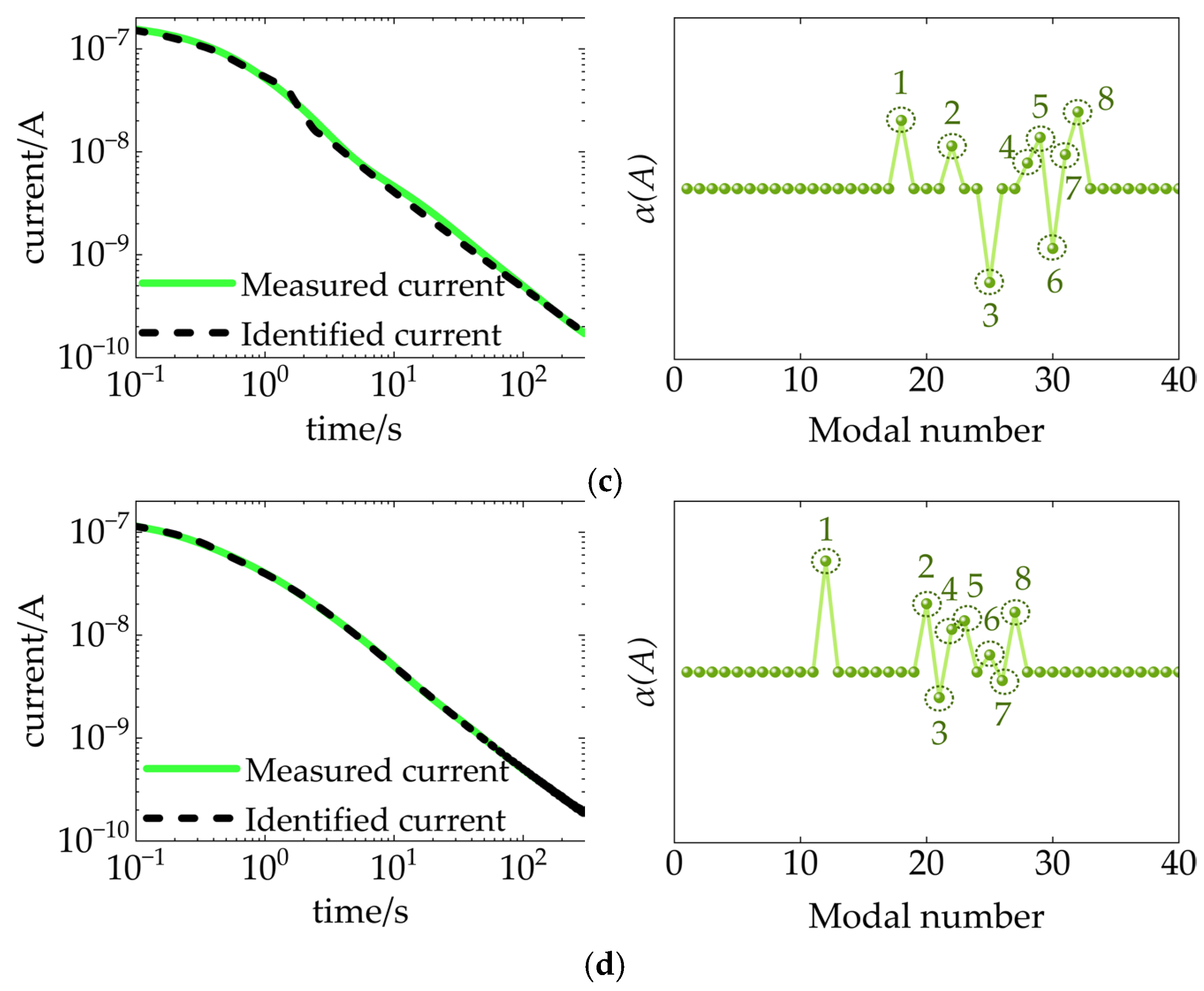
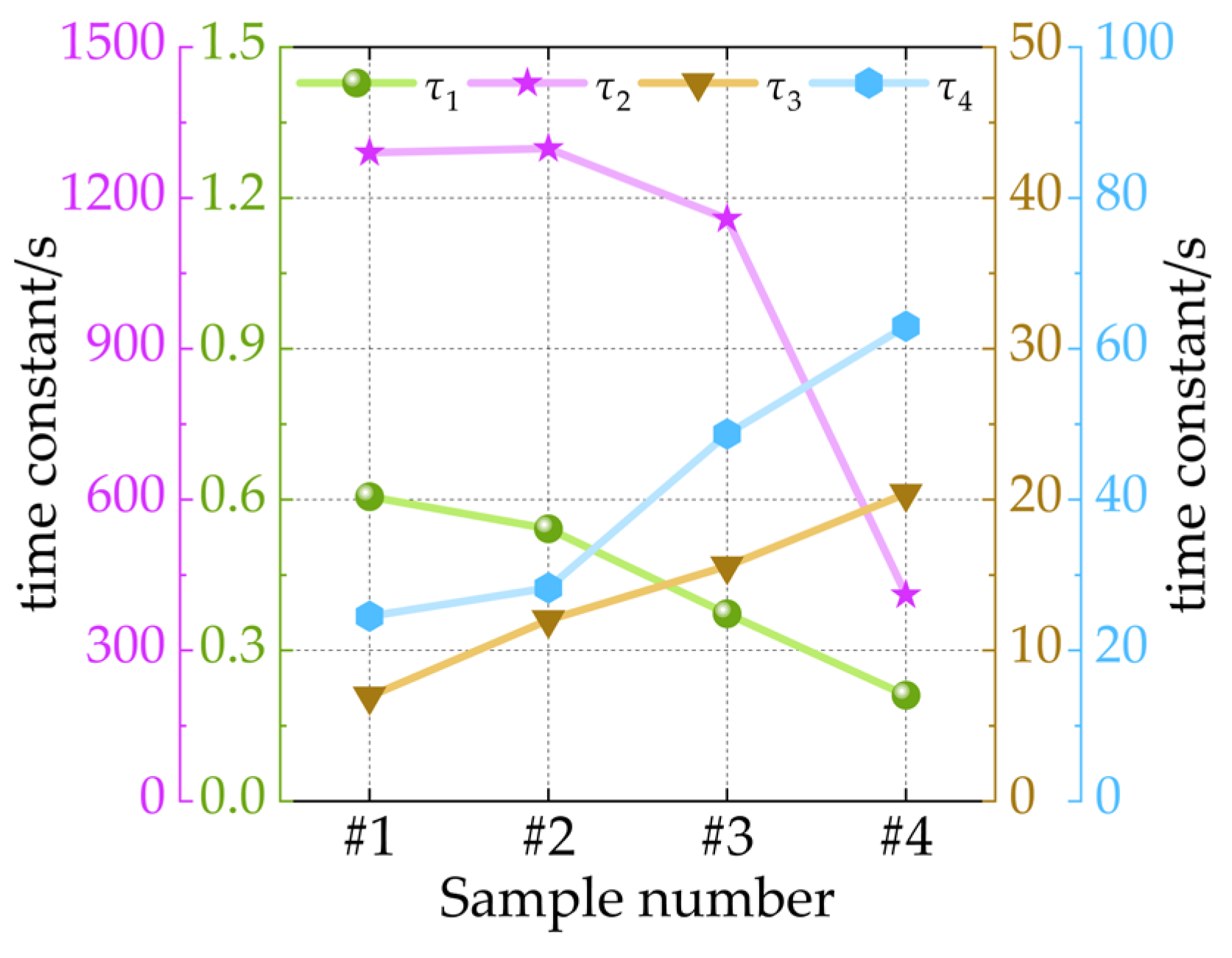
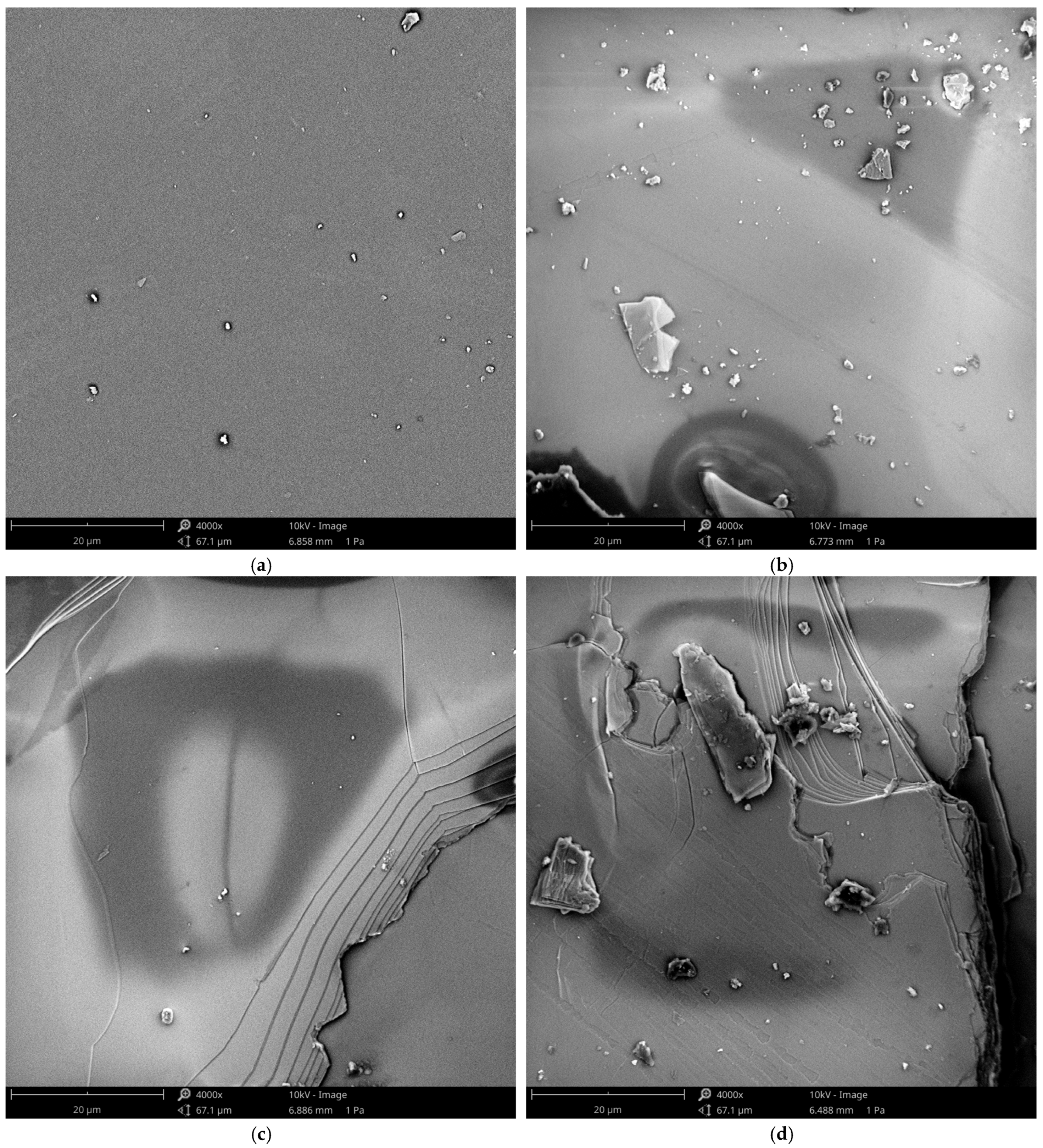
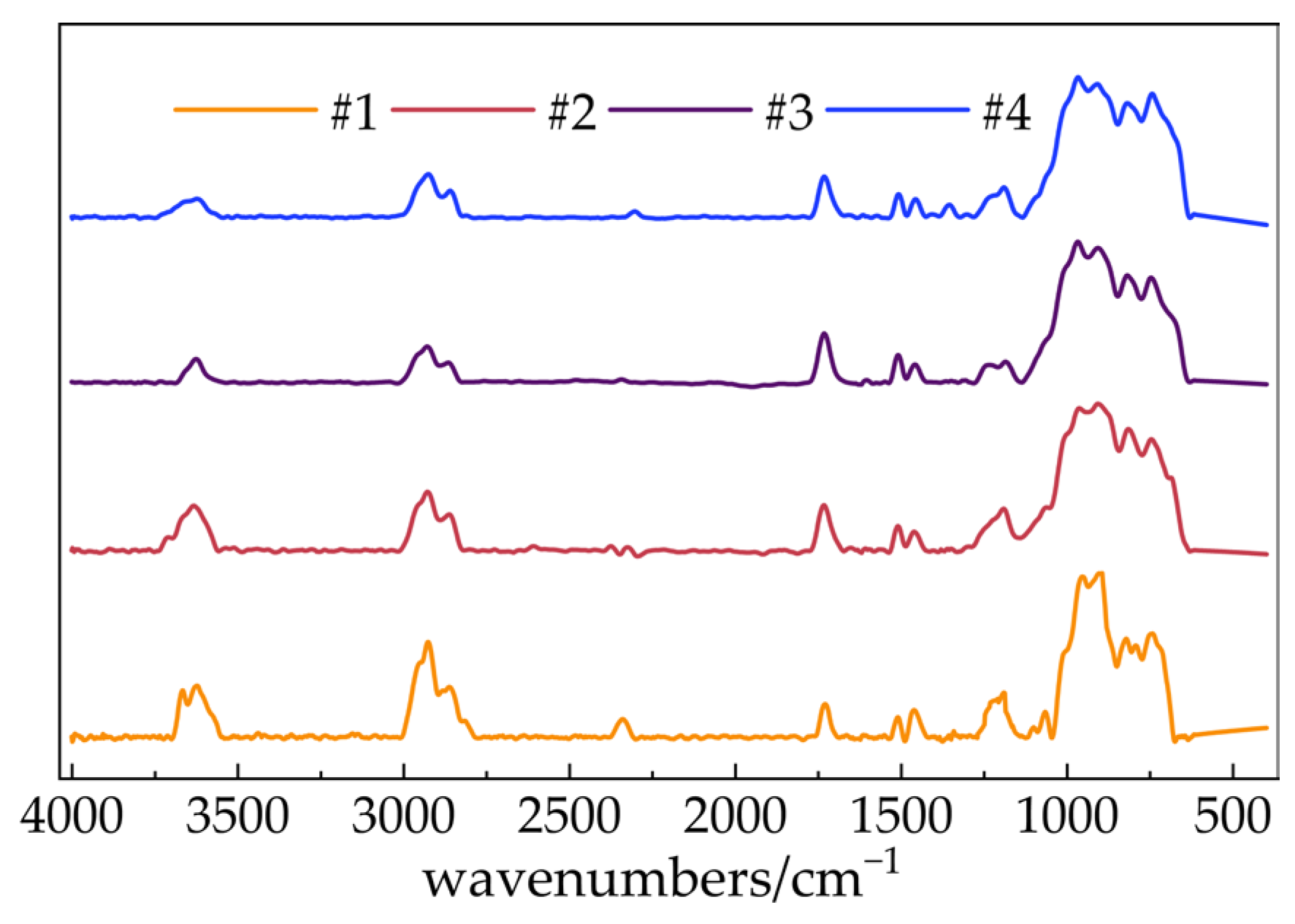
| Branch i | Relaxation Strength Ai/nA | Time Constant τi/s |
|---|---|---|
| 1 | 40 | 150 |
| 2 | 240 | 60 |
| 3 | 510 | 10 |
| 4 | 850 | 0.6 |
| SNR | Branch i | Relaxation Strength Ai/nA | Time Constant τi/s |
|---|---|---|---|
| 50 dB | 1 | 38.498 | 155.765 |
| 2 | 240.92 | 60.608 | |
| 3 | 511.566 | 10.002 | |
| 4 | 849.286 | 0.6 | |
| 40 dB | 1 | 42.176 | 150.691 |
| 2 | 231.931 | 61.913 | |
| 3 | 499.291 | 10.083 | |
| 4 | 833.349 | 0.598 | |
| 30 dB | 1 | 46.755 | 152.273 |
| 2 | 221.533 | 62.412 | |
| 3 | 523.936 | 10.021 | |
| 4 | 844.836 | 0.599 |
| Sample Number | Sample Processing |
|---|---|
| #1 | Thermal aging 0 days |
| #3 | Thermal aging 10 days |
| #2 | Thermal aging 20 days |
| #4 | Thermal aging 30 days |
| Sample Number | R2 |
|---|---|
| #1 | 0.9987 |
| #3 | 0.9963 |
| #2 | 0.9961 |
| #4 | 0.9998 |
Disclaimer/Publisher’s Note: The statements, opinions and data contained in all publications are solely those of the individual author(s) and contributor(s) and not of MDPI and/or the editor(s). MDPI and/or the editor(s) disclaim responsibility for any injury to people or property resulting from any ideas, methods, instructions or products referred to in the content. |
© 2025 by the authors. Licensee MDPI, Basel, Switzerland. This article is an open access article distributed under the terms and conditions of the Creative Commons Attribution (CC BY) license (https://creativecommons.org/licenses/by/4.0/).
Share and Cite
Zhu, G.; Ma, S.; Yang, S.; Zhang, Y.; Wang, B.; Zhou, K. Identification of Dielectric Response Parameters of Pumped Storage Generator-Motor Stator Winding Insulation Based on Sparsity-Enhanced Dynamic Decomposition of Depolarization Current. Energies 2025, 18, 3382. https://doi.org/10.3390/en18133382
Zhu G, Ma S, Yang S, Zhang Y, Wang B, Zhou K. Identification of Dielectric Response Parameters of Pumped Storage Generator-Motor Stator Winding Insulation Based on Sparsity-Enhanced Dynamic Decomposition of Depolarization Current. Energies. 2025; 18(13):3382. https://doi.org/10.3390/en18133382
Chicago/Turabian StyleZhu, Guangya, Shiyu Ma, Shuai Yang, Yue Zhang, Bingyan Wang, and Kai Zhou. 2025. "Identification of Dielectric Response Parameters of Pumped Storage Generator-Motor Stator Winding Insulation Based on Sparsity-Enhanced Dynamic Decomposition of Depolarization Current" Energies 18, no. 13: 3382. https://doi.org/10.3390/en18133382
APA StyleZhu, G., Ma, S., Yang, S., Zhang, Y., Wang, B., & Zhou, K. (2025). Identification of Dielectric Response Parameters of Pumped Storage Generator-Motor Stator Winding Insulation Based on Sparsity-Enhanced Dynamic Decomposition of Depolarization Current. Energies, 18(13), 3382. https://doi.org/10.3390/en18133382





